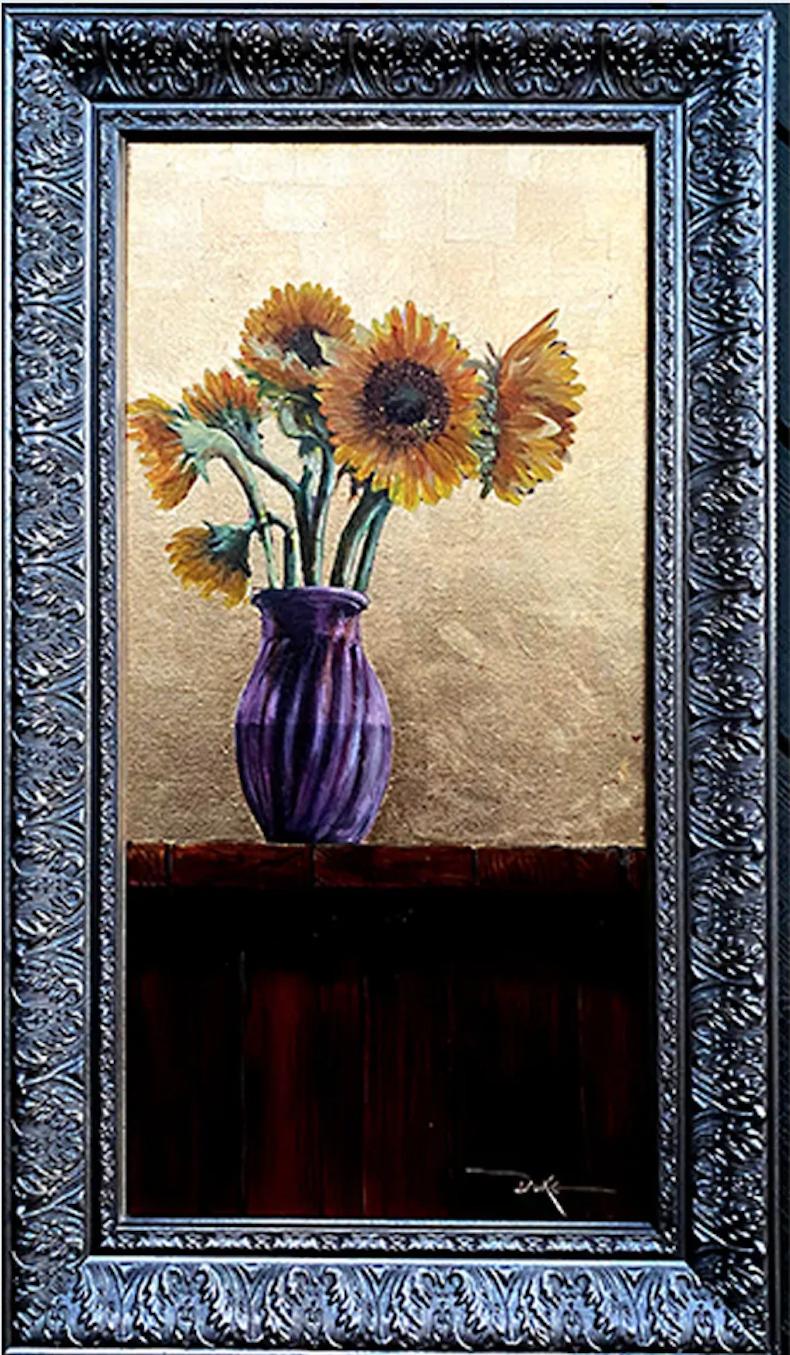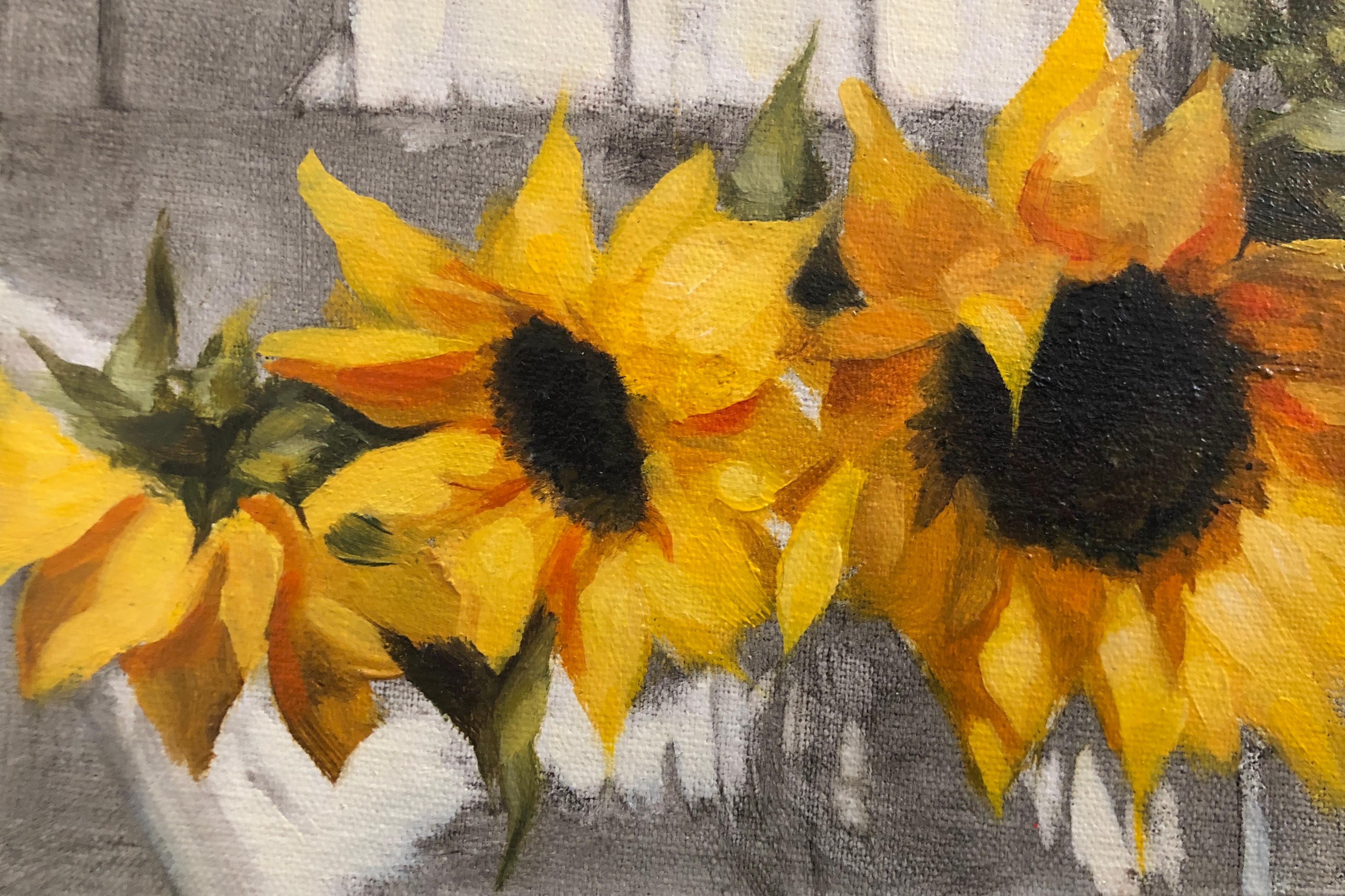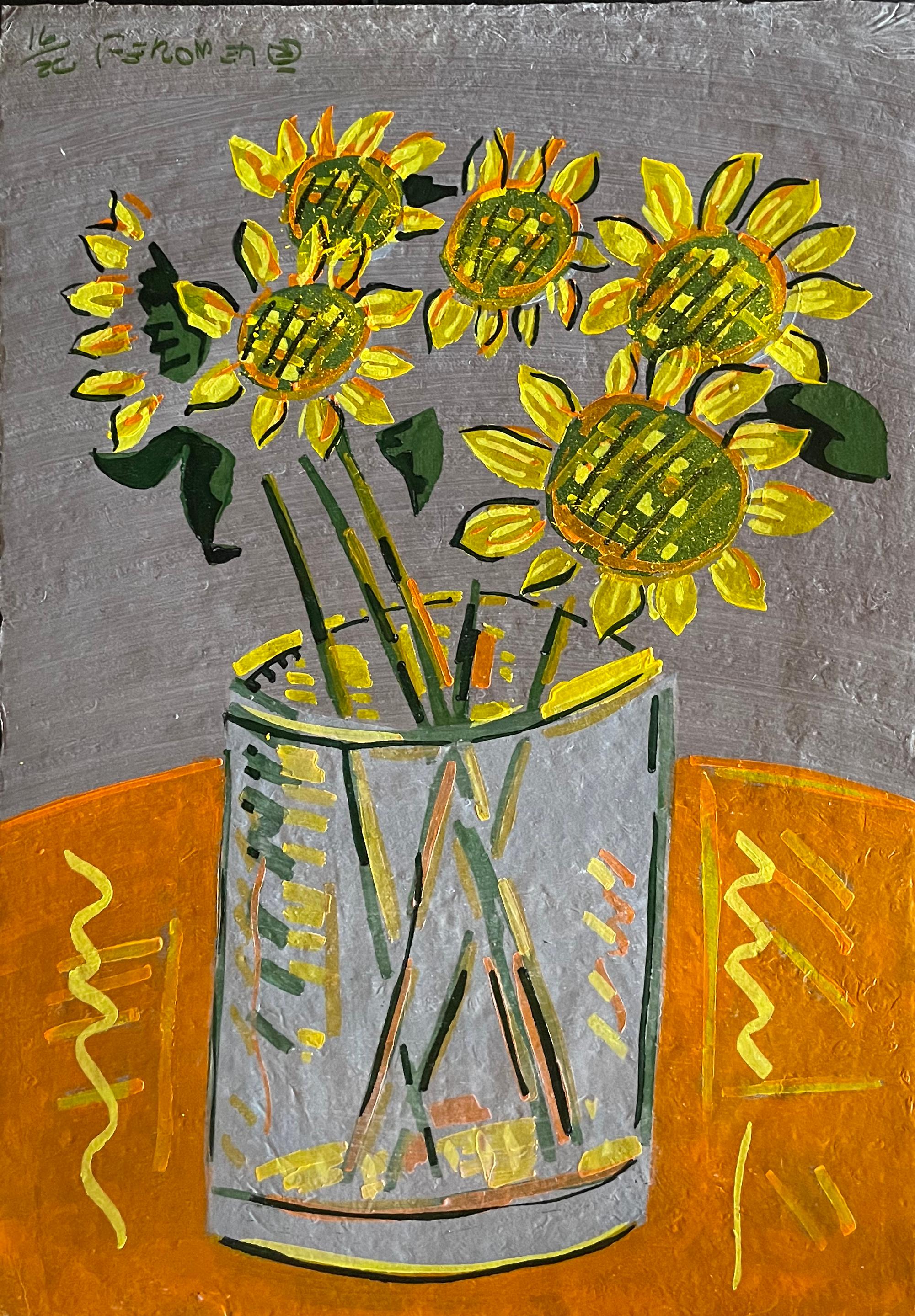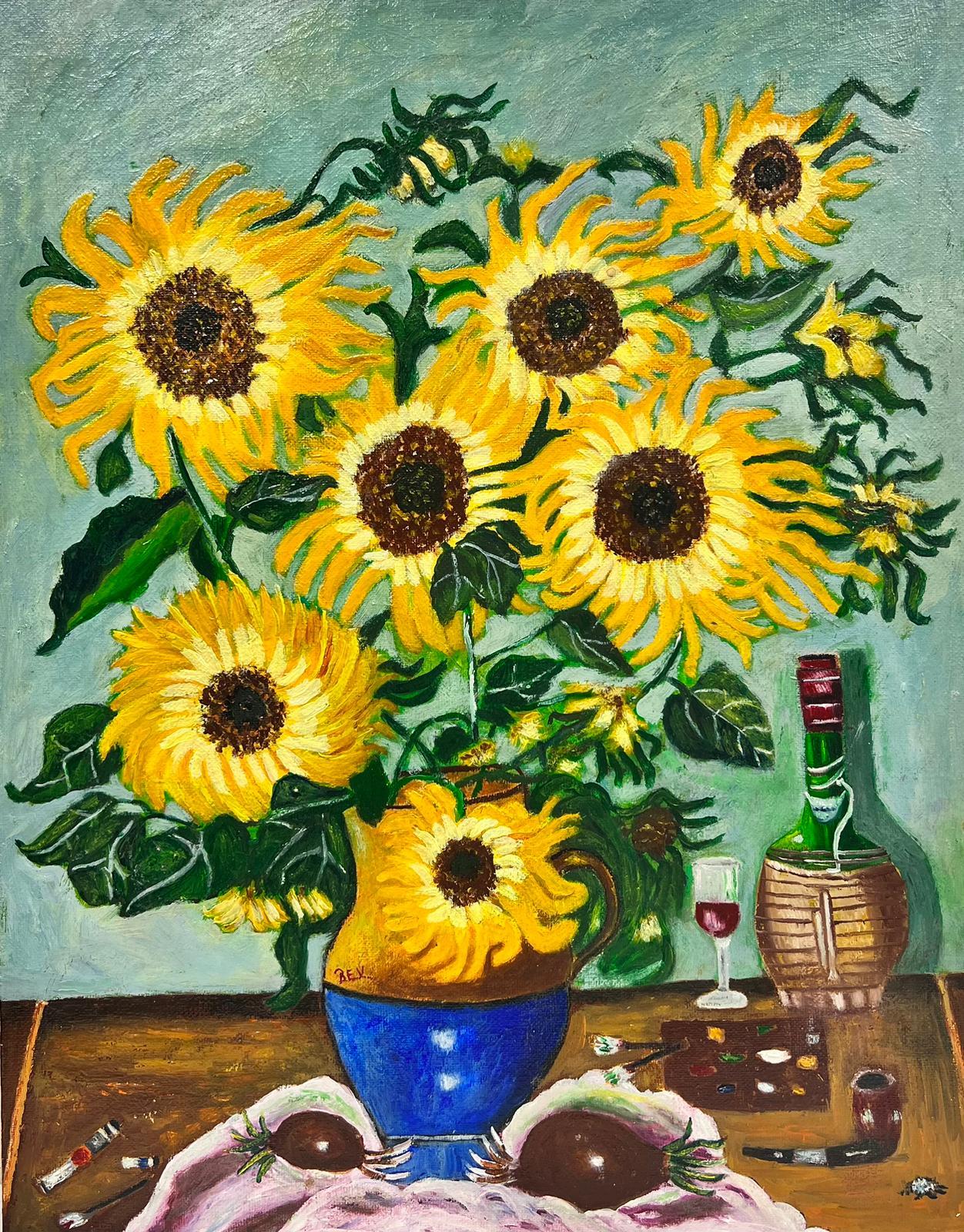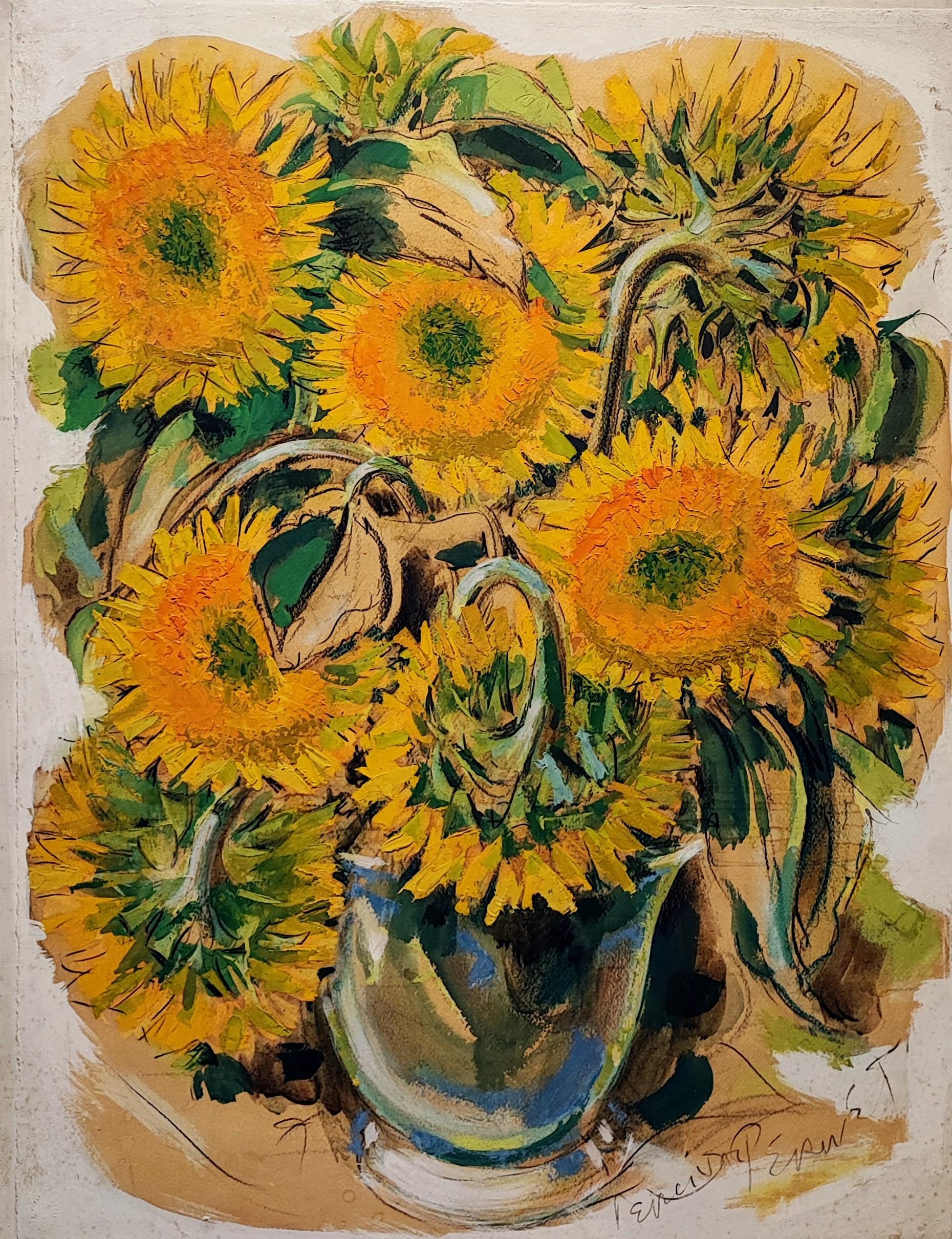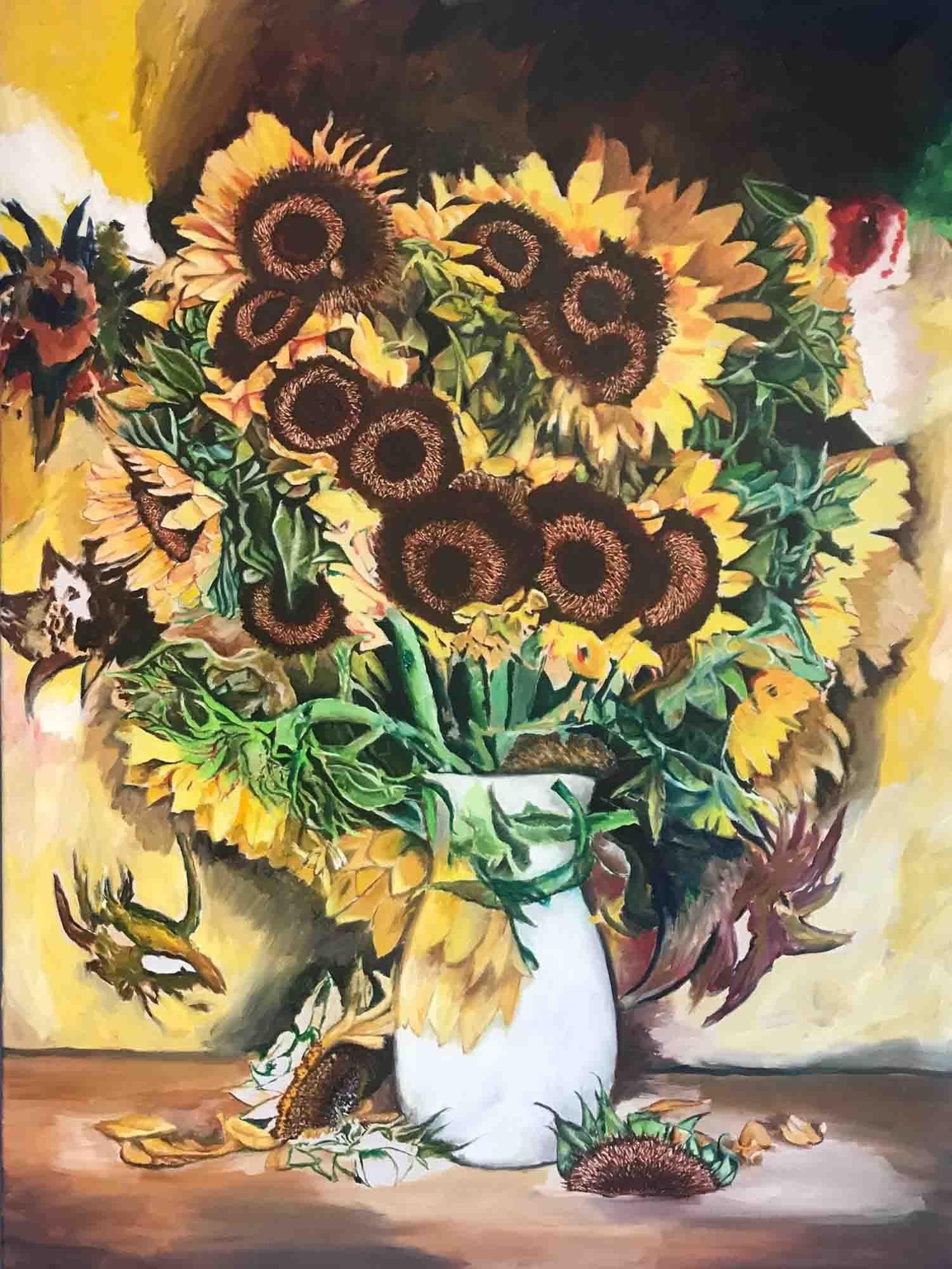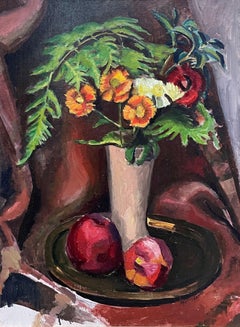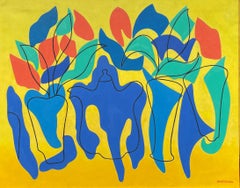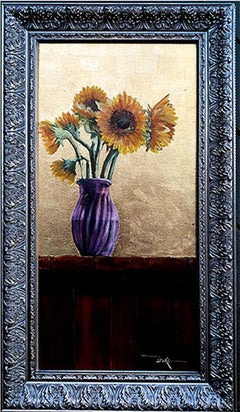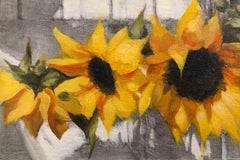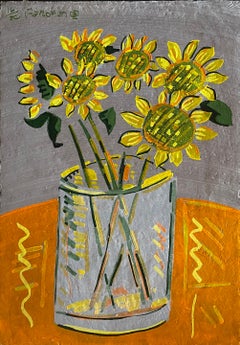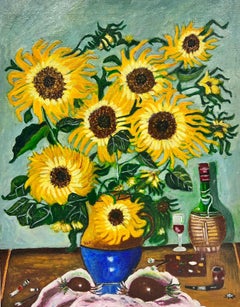Items Similar to "Sunflowers, " Frank London, Modernist Yellow Floral Still Life with Window
Want more images or videos?
Request additional images or videos from the seller
1 of 10
Frank London"Sunflowers, " Frank London, Modernist Yellow Floral Still Life with Window
$5,000
£3,793.88
€4,337.97
CA$6,983.64
A$7,764.86
CHF 4,054.38
MX$94,517.28
NOK 51,732.16
SEK 48,470.56
DKK 32,375.06
Shipping
Retrieving quote...The 1stDibs Promise:
Authenticity Guarantee,
Money-Back Guarantee,
24-Hour Cancellation
About the Item
Frank Marsdon London (1876 - 1945)
Sunflowers
Oil on canvas
31 x 22 inches
Signed lower right
Exhibited:
Pittsburgh, Carnegie Museum of Art.
Frank Marsden London was born in the small Southern town of Pittsboro in central North Carolina in 1876. When he reached adulthood, London attended the University of North Carolina for two years before moving to New York City to pursue a career in the arts. While in New York he studied at the Pratt Institute in Brooklyn and with William Merritt Chase at the Chase School of Art. London also traveled to Europe where he was very inspired by the French modernist, Paul Cezanne, and perhaps by the work of the Surrealists.
Following the completion of his art education, London returned to North Carolina. He established an ecclesiastical art business and designed stained glass windows and other decorative art for churches. An example of his stained glass work can be seen at the Episcopal Church of the Good Shepherd in Raleigh. However, in 1923, London sold his business and dedicated the rest of his life to painting, his true passion. He was an active member of the Woodstock Art Association in Upstate New York and he held several exhibitions at the North Carolina Museum of Art. His work can also be viewed at the Mint Museum in Charlotte and at the University of North Carolina. He died in 1945.
- Creator:Frank London (1876 - 1945, American)
- Dimensions:Height: 34 in (86.36 cm)Width: 25.5 in (64.77 cm)
- Medium:
- Movement & Style:
- Period:
- Condition:
- Gallery Location:New York, NY
- Reference Number:1stDibs: LU184129930872
About the Seller
5.0
Platinum Seller
Premium sellers with a 4.7+ rating and 24-hour response times
Established in 2022
1stDibs seller since 2022
115 sales on 1stDibs
Typical response time: <1 hour
- ShippingRetrieving quote...Shipping from: New York, NY
- Return Policy
Authenticity Guarantee
In the unlikely event there’s an issue with an item’s authenticity, contact us within 1 year for a full refund. DetailsMoney-Back Guarantee
If your item is not as described, is damaged in transit, or does not arrive, contact us within 7 days for a full refund. Details24-Hour Cancellation
You have a 24-hour grace period in which to reconsider your purchase, with no questions asked.Vetted Professional Sellers
Our world-class sellers must adhere to strict standards for service and quality, maintaining the integrity of our listings.Price-Match Guarantee
If you find that a seller listed the same item for a lower price elsewhere, we’ll match it.Trusted Global Delivery
Our best-in-class carrier network provides specialized shipping options worldwide, including custom delivery.More From This Seller
View All"Mums" William S. Schwartz, Yellow Flowers, Cubist, Modern Still Life
By William S. Schwartz
Located in New York, NY
William S. Schwartz
Still Life with Yellow Mums, circa 1950
Signed lower right
Oil on canvas
20 x 16 inches
Provenance:
Private Collection, Massachusetts
William Schwartz was born in Smorgon, Russia, in 1896, one of nine children in a poor family. He studied art at an early age, earning a scholarship at the Vilna Art School in Russia, 1908–12. He immigrated to the United States at age 17 in 1913, living in New York with his sister for eight months and then moving to Omaha, Nebraska, to live with his brother in 1915. Working as a house painter, he turned his attention to art, studying briefly with J. Laurie Wallace at the Kellom School in Omaha before moving to Chicago. He entered the School of the Art Institute of Chicago (SAIC) in 1916, studying with Ivan Trutnev and Karl A. Buehr, and graduating with honors in life drawing, portraiture, and painting in 1917. He supported himself as a tenor singer in vaudeville, concerts, and opera and received favorable reviews, but he chose to pursue painting instead of singing. His circle of artist friends included important Chicago modernists Aaron Bohrod, Malvin and Ivan Albright, Archibald Motley Jr., and Anthony Angarola...
Category
Mid-20th Century Cubist Still-life Paintings
Materials
Canvas, Oil
"Untitled" Albert Heckman, Modernist Saturated Blue and Yellow Still Life
By Albert Heckman
Located in New York, NY
Albert Heckman
Untitled, circa 1950
Signed lower right
Oil on canvas
18 x 24 inches
Albert Heckman was born in Meadville, Western Pennsylvania, 1893. He went to New York City to try his hand at the art world in 1915 after graduating from high school and landing a job at the Meadville Post Office. In 1917, at the age of 24, Heckman enrolled part-time in Teachers' College, Columbia University's Fine Arts Department to begin his formal art education. He worked as a freelance ceramic and textile designer and occasionally as a lecturer at the Metropolitan Museum of Art. In the early 1920s, at the age of almost 30, he graduated with a Bachelor of Arts degree from Columbia Teachers College. He was especially impacted by his instructor at Columbia, Arthur Wesley Dow.
After graduating, he was hired by the Teachers' College as a Fine Arts instructor. He stayed with Columbia Teachers' College until 1929, when he left to attend the Leipzig Institute of Graphic Arts in Leipzig, Germany. Isami Doi (1903-1965), who was born in Hawaii, was arguably his most impressive student at Columbia. Doi is now regarded as one of the most prominent artists hailing from Hawaii. Heckman became an active member and officer of the Keramic Society and Design Guild of New York in the 1920s as part of his early commercial art career. The Society's mission was to share knowledge and showcase textile and ceramic design exhibits.
In 1922, Heckman married Florence Hardman, a concert violinist. Mrs. Heckman's concert schedule during the 1920s kept Albert and Florence Heckman apart for a significant portion of the time, but they spent what little time they had together designing and building their Woodstock, New York, summer house and grounds. A small house and an acre of surrounding land on Overlook Mountain, just behind the village of Woodstock, were purchased by Albert and Florence Heckman at the time of their marriage. Their Woodstock home, with its connections, friendships, and memories, became a central part of their lives over the years, even though they had an apartment in New York City.
Heckman's main artistic focus shifted to the house on Overlook Mountain and the nearby towns and villages, Kingston, Eddyville, and Glasco. After returning from the Leipzig Institute of Graphic Arts in 1930, Mr. Heckman joined Hunter College as an assistant professor of art. He worked there for almost thirty years, retiring in 1956. Throughout his tenure at Hunter, Mr. Heckman and his spouse spent the summers at their Woodstock residence and the winters in New York City. They were regular and well-known guests at the opera and art galleries in New York. Following his retirement in 1956, the Heckmans settled in Woodstock permanently, with occasional trips to Florida or Europe during the fall and winter. Mr. Heckman's close friends and artistic career were always connected to Woodstock or New York City. He joined the Woodstock art group early on and was greatly influenced by artists like Paul and Caroline Rohland, Emil Ganso, Yasuo Kuniyoshi, Andre Ruellan, and her husband, Jack...
Category
1950s Modern Interior Paintings
Materials
Oil, Canvas
"Floral Still Life with Two Apples" Hayley Lever, Modernist Still Life Painting
By Hayley Lever
Located in New York, NY
Hayley Lever
Floral Still Life with Two Apples
Signed lower right
Oil on canvas
20 x 16 inches
Hayley Lever’s versatility has worked against his posthumous reputation. He was never...
Category
Early 20th Century Modern Still-life Paintings
Materials
Canvas, Oil
"Untitled" Albert Heckman, Still Life, Floral Abstracted Modernist Composition
By Albert Heckman
Located in New York, NY
Albert Heckman
Untitled, circa 1950
Signed lower right
Oil on canvas
25 1/4 x 32 1/4 inches
Albert Heckman was born in Meadville, Western Pennsylvania, 1893. He went to New York City to try his hand at the art world in 1915 after graduating from high school and landing a job at the Meadville Post Office. In 1917, at the age of 24, Heckman enrolled part-time in Teachers' College, Columbia University's Fine Arts Department to begin his formal art education. He worked as a freelance ceramic and textile designer and occasionally as a lecturer at the Metropolitan Museum of Art. In the early 1920s, at the age of almost 30, he graduated with a Bachelor of Arts degree from Columbia Teachers College. He was especially impacted by his instructor at Columbia, Arthur Wesley Dow.
After graduating, he was hired by the Teachers' College as a Fine Arts instructor. He stayed with Columbia Teachers' College until 1929, when he left to attend the Leipzig Institute of Graphic Arts in Leipzig, Germany. Isami Doi (1903-1965), who was born in Hawaii, was arguably his most impressive student at Columbia. Doi is now regarded as one of the most prominent artists hailing from Hawaii. Heckman became an active member and officer of the Keramic Society and Design Guild of New York in the 1920s as part of his early commercial art career. The Society's mission was to share knowledge and showcase textile and ceramic design exhibits.
In 1922, Heckman married Florence Hardman, a concert violinist. Mrs. Heckman's concert schedule during the 1920s kept Albert and Florence Heckman apart for a significant portion of the time, but they spent what little time they had together designing and building their Woodstock, New York, summer house and grounds. A small house and an acre of surrounding land on Overlook Mountain, just behind the village of Woodstock, were purchased by Albert and Florence Heckman at the time of their marriage. Their Woodstock home, with its connections, friendships, and memories, became a central part of their lives over the years, even though they had an apartment in New York City.
Heckman's main artistic focus shifted to the house on Overlook Mountain and the nearby towns and villages, Kingston, Eddyville, and Glasco. After returning from the Leipzig Institute of Graphic Arts in 1930, Mr. Heckman joined Hunter College as an assistant professor of art. He worked there for almost thirty years, retiring in 1956. Throughout his tenure at Hunter, Mr. Heckman and his spouse spent the summers at their Woodstock residence and the winters in New York City. They were regular and well-known guests at the opera and art galleries in New York. Following his retirement in 1956, the Heckmans settled in Woodstock permanently, with occasional trips to Florida or Europe during the fall and winter. Mr. Heckman's close friends and artistic career were always connected to Woodstock or New York City. He joined the Woodstock art group early on and was greatly influenced by artists like Paul and Caroline Rohland, Emil Ganso, Yasuo Kuniyoshi, Andre Ruellan, and her husband, Jack Taylor.
Heckman operated a summer art school in Woodstock for several years in the 1930s with support from Columbia University, where these and other Woodstock artists gave guest lectures. The Potter's Shop in New York City hosted Mr. Heckman's first art show in December 1928. The exhibit received some positive reviews from critics. The American Institute of Graphic Arts chose the plate of "Wehlen, Saxony" as one of the "Fifty Prints of the Year in 1929." There were sixteen etchings displayed. The remaining plates depicted scenes in Saxony, Germany, while five of the plates were based on scenes in Rondout, New York.
Heckman started switching from etching to black and white lithography by the early 1930s. A lifelong admirer of Heckman's artwork, Mr. Gustave von Groschwitz organized a significant exhibition of Heckman etchings and lithographs at the Ferargil Gallery in New York City in 1933. The exhibition traveled to the Stendahl Galleries in Los Angeles (May 1933), the Charles Lessler Gallery in Philadelphia (May 1933), J.L. Hudson in Detroit (June 1933), and Gumps in San Francisco (July 1933). Together with his early etchings, the exhibition featured brand-new black and white lithographs depicting scenes in and around Woodstock as well as "A View from Tudor City...
Category
1950s Abstract Figurative Paintings
Materials
Canvas, Oil
"Flowers" Mary Abbott, Colorful Floral Still Life, Female Abstract Expressionism
By Mary Abbott
Located in New York, NY
Mary Abbott
Flowers, circa 1950
Signed lower left
Pastel on paper
30 x 22 1/4 inches
Provenance:
Aaron Galleries, Glenview, Illinois
Among the early exponents of Abstract Expressio...
Category
1950s Abstract Still-life Paintings
Materials
Paper, Pastel
"Tulips" Daphne Mumford, Bright and Colorful Floral Diptych
Located in New York, NY
Daphne Mumford
Tulips
Signed lower right, titled on each stretcher
Oil on canvas, diptych
24 x 74 inches
Daphne Mumford studied at the Skowhegan School of Painting in 1952; the Chel...
Category
Late 20th Century Still-life Paintings
Materials
Canvas, Oil
You May Also Like
Impressionist Still Life Painting, "Sunflowers II"
Located in San Diego, CA
This is a one of a kind original acrylic and gold leaf still life painting by San Diego artist, Duke Windsor. A certificate of authenticity will follow de...
Category
2010s Impressionist Still-life Paintings
Materials
Gold Leaf
"Sunflowers" (2022) Original Painting by Barbara Hack - Floral Still Life
Located in Denver, CO
Barbara Hack presents "Sunflowers," an original oil painting on canvas panel created in 2022. This delightful piece measures 4 x 6 x 1 inch (10.16 x 15.24 x 2.54 cm) and is elegantly...
Category
2010s Impressionist Figurative Paintings
Materials
Canvas, Oil, Panel
Sunflowers, by Frank Romero
By Frank Romero
Located in Palm Springs, CA
Though it is stated as an edition of 20, each print in the edition is unique, with handpainting along with stencil painting. Completed on a trip to Paris, it is on a hand-made paper from Bhutan.
Throughout his 40 year career as an artist, Frank Romero has been a dedicated member of the Los Angeles arts community. As a member of the 1970s Chicano art collective, Los Four...
Category
Early 2000s Contemporary Still-life Prints
Materials
Paint, Screen, Stencil
$1,400 Sale Price
20% Off
Contemporary British Acrylic Painting Sunflowers in Vase
Located in Cirencester, Gloucestershire
Sunflowers
by Ben George Powell, British contemporary artist
signed
acrylic on canvas, unframed
canvas: 18 x 14 inches
provenance: private collection of this artists work, UK
The pai...
Category
21st Century and Contemporary Impressionist Still-life Paintings
Materials
Oil, Acrylic
Bouquet of sunflowers
Located in Genève, GE
Work on paper mounted on cardboard
Brown wooden frame
93.5 x 71 x 3.5 cm
Category
Mid-20th Century Modern Still-life Paintings
Materials
Gouache
SUNFLOWERS, Painting, Oil on Canvas
By Vincent Zambrano
Located in Yardley, PA
This painting was inspired by Vincent Van Gogh's "Sunflowers". I came up with my own image based on 3 still images merge into 1. :: Painting :: Contemporary :: This piece comes with...
Category
2010s Contemporary Paintings
Materials
Oil
More Ways To Browse
Antique French Window
Painting Antique Windows
Small Antique Windows
Ecclesiastical Art
The Good Shepherd
Antique Church Window
Antique Pittsburgh Glass
English Etching
Russian Book
Black Sculpture Of A Man
Leger Lithograph
Antique New York Art Prints
Bird Lithograph
Japanese Woman
Avant Garde Sculpture
Framed Horse Prints
Vintage Sign Letters
Henri Matisse Signed
